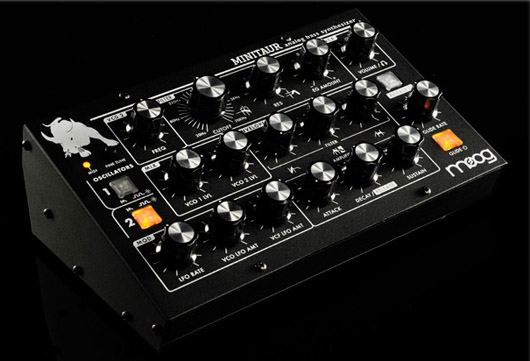Review: Moog Minitaur
MSRP: $679, Moog In the past few years, the synth builders at Moog have made […]

MSRP: $679, Moog
In the past few years, the synth builders at Moog have made valiant attempts to make their legendary synths much more affordable and accessible to a larger group of users without losing their excellent, continually sought after sound quality. Rather than using cheaper materials, however, the company has achieved its goal by manufacturing truncated versions of their products, dropping features and shaving off a number of bells and whistles to accomplish a new price point. The Minitaur is such a unit, designed after the sound-generation components which make up the Tauras 3 bass synth, a piece that was recentely discontinued.
First off, the Minitaur is a very compact unit, taking up 8.5″ x 5.25″ of table space and making it smaller than any hardware synth (with or without a keyboard) that Moog has manufactured to date. In fact, the Minitaur takes up about as much space as one of the brand’s Moogerfooger pedals turned sideways. Fortunately, with this smaller surface area, Moog was still able to fit a dedicated knob or button for each and every adjustable parameter available on the Minitaur. The two oscillators can individually toggle between sawtooth (the original Taurus shape) or square waveforms, and from there can be ran through a standard signal path that includes a low-pass filter section, standard envelope controls, glide, and LFO-based modulation—all with large, smooth-turning knobs assigned to each particular point of customization. The Minitaur also comes without a keyboard, instead giving the user MIDI and USB ports on the back of the unit to allow the control to come from an external keyboard or directly from one’s production software. The Minitaur does not offer much in the way of options beyond these controls���after all, it is made to be a bass synth, and the ethos here seems to be one of simpler is better. There is no individual octave control for the oscillators, and although the second oscillator’s pitch can be tweaked and detuned (which can help achieve some really thick bass sounds), both oscillators are always in the same octave range. The oscillators can only go up to a certain pitch as well, meaning that even if your MIDI keyboard can access those higher octaves, the synth will eventually not be able to keep up with it, tapping out somewhere around a mid-range lead. Of course, this is bass synth though, and the sacrificing of those higher tones is no doubt due to an emphasis by the designers on the lower end of the sonic spectrum.
But what we really want to know is: Does the Minitaur sound like a Moog? Truthfully, it’s hard to say whether the unit is a faithful representation of the original Taurus (or even the more recent Taurus 3), but the Minitaur definitely does have that warm, full Moog sound that you would expect. Furthermore, maybe the absence of the options that one would be used to finding on the company’s other units (like the Voyager and the Phatty) actually ends up helping achieve this rich, massive sound. In addition to the thickness inherent in the oscillator’s wave shape, the low-pass filter is largely responsible for this sound, and what’s more, the Minitaur does allow for an external audio input via a quarter-inch input jack on the back of the unit, so you can run any sound source through the filter and modulation sections.
The Minitaur is not a versatile synth by any stretch of the imagination. Like all Moog hardware units, it’s monophonic, and compared to a lot of other pieces on the market for around the same price, its feature list is a bit on the short side. That said, the focus at Moog has always been on sound above all else, and the Minitaur surely delivers in that respect. Given its sonic capabilities and its ability to integrate into the modern studio, the Minitaur is yet another Moog unit that finds a great balance between quality and affordability while staying true to the company’s time-tested reputation.

